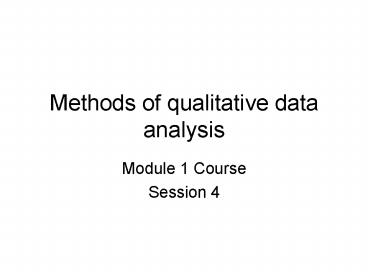Methods of qualitative data analysis PowerPoint PPT Presentation
1 / 16
Title: Methods of qualitative data analysis
1
Methods of qualitative data analysis
- Module 1 Course
- Session 4
2
"What do we do with these disorderly piles of
data?" (Lewis 1991)
- Reducing the discursive data to manageable
proportions? - Distilling the meaning from the qualitative
interviews? - Requirement Being systematic!
- for exhaustiveness (nothing left out)
- for credibility (no bias)
3
We need methods for
- Organizing the interview text (manageability)
- Analysing the manifest meanings ('essence')
- Interpreting latent meanings (beneath the
surface) - No magical tool just hard work!
4
Transcribing interviews
- Different practices academic vs. commercial
research - Transcribe in toto all utterances, verbatim,
indicate 'circumstances of the utterance
(laughter, irony, gesture, facial) - The best way to defeat faulty first impressions
- Go back to the tapes a more faithful rendering
of what was said and how
5
We don't start from scratch!(as in radical
grounded theory)
- "The central task of interview analysis rests
with the researcher, with the thematic questions
he or she has asked from the start of the
investigation and followed up through designing,
interviewing, and transcribing." (Kvale, 187) - Start with the themes of the interview guide!
- (Researching Audiences Box 9.2 and 9.4)
6
The pervasiveness of interpretation 1
- 'analysis' vs. 'interpretation' a positivist
misconception interpretation is not an isolated
stage! BUT - Kvale pragmatically distinguishes surface
'analytical' operations from deeper kinds of
'interpretative' operations (188,193, 201) - ANALYSIS text reduction, manifest meanings, what
is directly said, more objective - INTERPRETATION text expansion, deeper
dimensions, meanings not apparent, more
speculative
7
The pervasiveness of interpretation 2
- - also the lesson from the Chinese Boxes model
- The outer box The meaning construction process
goes on making sense of/interpreting/decoding
the transcript. - Two dimensions to analyse
- 1. Language representing social reality, talking
about the world - 2. Language as patterns of interaction,
turn-taking, co-production of meaning,
negotiation of agreement.
8
9
5 approaches to interview analysis
- Meaning condensation one looks for the natural
meaning units in the interview (e.g. a couple of
paragraphs) and rephrases them as a 'theme'. (Ex.
Kvale p.195) - little interpretation involved - the analyst
tries phenomenologically - to be the
informants mouthpiece (Kvale p. 196). - Corp.ad. study articulating the essence of an
informant's experience of one ad
10
- Categorization the analyst codes aspects of the
interview text into a small number of dimensions
or categories "This experience is X or Y or Z".
On the road to quantification. - Corp.ad study This experience of ad A is
category Symp/Agn/Cyn. - Narrative analysis registers stories told during
interviews plot, good versus bad, the point of
the narrative. Or analyst creates a coherent
story out of the many happenings reported
throughout an interview - Corp.ad study Not used.
11
- Interpretation analyst looks for latent
meanings, beyond a structuring of the manifest
meanings to deeper and more or less speculative
interpretations. - inferential meanings "profits cut dramatically"
(Res.Aud. 168). - everyday metaphors "add a bit of spice", "just
myself again" (Res.Aud. 167)
12
- Ad Hoc meaning generation
- Using different approaches and techniques for
meaning generation (e.g. the previous 4) - "free interplay of techniques"
- No standard method
- "We believe that to use any one interpretive tool
is insufficient to deal with the richness of the
interview data. () we recommend the ad hoc
procedure, as long as it remains systematically
structured and does not become idiosyncratic and
impressionistic" (Res.Aud. p. 166 )
13
Benefits of 'categorization'
- Potentially provides an overview over the
meanings experienced by the informant (Kvale
fig.11.3, p. 198). - Corp.ad study 1. Constructing each informant as
an 'aggregate' category of Sym/Agn/Cyn. 2.
Constructing a map for positioning informants in
landscape of intersecting Sym/Agn/Cyn
territories. - Provides a basis for determining typicality of
each informant. - Potentially enables social differentiation
between informants (level of education). - Potentially enables comparisons (DK vs. UK)
14
Limitations of 'categorization'
- Reduction of complexity
- Rendering ambivalences invisible
15
Control of analysis Credibility, quality,
craftmanship?
- Did other eyes see the same?
- Intercoder reliability/Multiple interpreters
- procedures for coding agreement.
- Interviewer reliability different interview
styles - Would other eyes see the same? (yours!)
- Documentation through procedural explicitness
and extensive transcript excerpts.
16
What reliability is all about- when more than
one interpretation is possible
- "The chief point to be remembered with this type
of research is not so much whether another
position with respect to the data could be
adopted (), but whether a reader, adopting the
same viewpoint as articulated by the researcher,
can also see what the researcher saw, whether or
not he agrees with it. That is the key criterion
for qualitative research."

